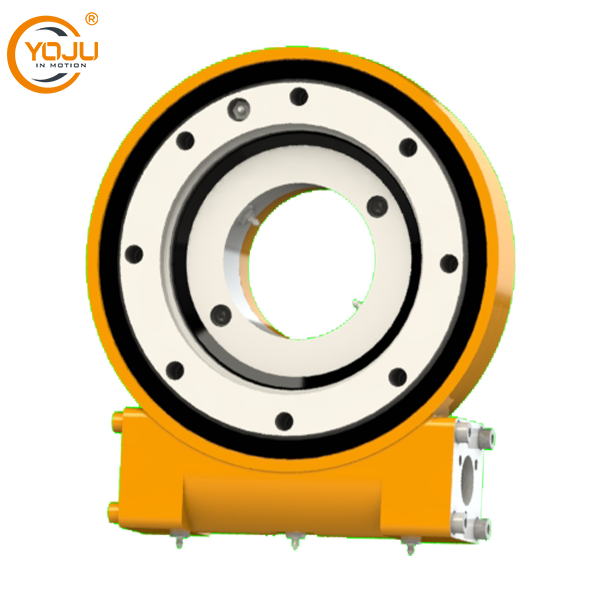In modern welding and fabrication, precision, repeatability, and operational efficiency are paramount. One component that has been gaining attention in industrial automation is the welding positioner slewing drive. By integrating advanced gear technology into traditional welding positioners, manufacturers are not only enhancing control but also unlocking new possibilities for heavy-duty fabrication tasks. In this blog post, YOJU, as high precision industrial equipment slew drive exporter, will share applications of welding positioner slewing drive in heavy industry.
Understanding the Role of Welding Positioner Slewing Drive
At its core, a welding positioner is designed to manipulate workpieces, allowing welders or automated systems to access optimal angles. The slewing drive for welding positioners acts as the rotational mechanism, transforming motor torque into smooth, controlled rotation. Unlike conventional gearboxes, slewing drives integrate worm gear systems with bearings, enabling higher load capacities and precise positioning.
This unique design ensures that large and asymmetrical workpieces can be rotated without compromising stability. As industries demand greater accuracy in automated welding, the slewing drive is emerging as the backbone of next-generation positioning systems.
Why Slewing Drives are Critical for Welding Positioners
The welding slewing drive system brings distinct advantages compared to standard drive mechanisms:
-
Compact integration: The gear and bearing are housed in a single, sealed unit.
-
Self-locking capability: Worm gear design resists back-driving, critical for safety in vertical welding applications.
-
High torque handling: Ensures smooth rotation even with oversized components.
But beyond these mechanical features, their importance lies in enabling safer, more efficient workflows. For industries such as shipbuilding, aerospace, and pressure vessel manufacturing, slewing drive welding positioners reduce reliance on manual adjustment while maintaining stringent welding standards.
Applications of Welding Positioner Slewing Drive in Heavy Industry
The use of slewing drive in welding positioners extends far beyond small workshops. Its adaptability is driving innovation in large-scale fabrication sectors:
-
Wind Tower Manufacturing – Tower sections weighing several tons require precise rotation during circumferential welding. Slewing drives ensure seamless control under extreme loads.
-
Pipeline Construction – For oil and gas projects, rotating massive cylindrical pipes becomes simpler with slewing-driven welding positioners.
-
Aerospace Components – Lightweight but complex structures demand fine-tuned welding angles, where high-precision slewing drives excel.
-
Structural Steel Fabrication – From bridges to high-rise supports, controlled welding rotation reduces deformation and guarantees consistent weld penetration.
Each of these sectors benefits not merely from increased efficiency, but from the repeatability and reliability that slewing drives bring into welding automation.

How Welding Positioner Slewing Drives Enhance Automation
With the rise of robotic welding, the slewing drive welding positioner acts as a synchronizing partner. Robotic arms require predictable workpiece movement, and slewing drives deliver precisely that. When coupled with CNC or PLC control systems, they enable:
-
Multi-axis welding sequences
-
Consistent rotation speeds matched to weld penetration requirements
-
Automated cycle repetition without operator intervention
This convergence of robotics and slewing drive-based welding positioners is paving the way for fully autonomous fabrication cells, capable of handling complex welds with minimal error.
Comparing Welding Positioner Slewing Drives with Conventional Rotation Systems
Traditional rotation systems often rely on chain or gear-driven mechanisms, which can wear unevenly, introduce backlash, or require frequent maintenance. In contrast, a slewing bearing drive for welding positioners combines load support and rotation in one assembly.
The result is:
-
Lower maintenance intervals
-
Enhanced stability for eccentric loads
-
A sealed system that resists dust, debris, and weld spatter
For fabrication environments where uptime directly impacts profitability, this design innovation represents a clear step forward.
Sustainability and Efficiency Through Slewing Drive Welding Positioners
One under-discussed aspect of welding positioner slewing drives is their contribution to sustainability. By ensuring precise positioning, less filler material is wasted, and weld rework is significantly reduced. Moreover, the compact, sealed design of slewing drives means lubrication requirements are minimized, reducing the environmental footprint of maintenance operations.
As industries push toward greener manufacturing, integrating slewing-driven welding positioners becomes not just a productivity choice, but also an eco-conscious decision.
Choosing the Right Slewing Drive for Welding Positioners
Not all slewing drives are created equal. When selecting a slewing drive for welding automation, manufacturers must consider:
-
Load capacity: Both axial and radial forces from the workpiece.
-
Rotation precision: Especially vital for automated robotic welding.
-
Sealing and protection: To withstand sparks, dust, and welding fumes.
-
Customization options: Some slewing drives can be designed with dual-axis control for more advanced positioning.
By aligning these parameters with application needs, companies can maximize both productivity and equipment lifespan.
The Future of Welding Positioner Slewing Drive Technology
As fabrication trends evolve, the role of welding positioner slewing drives will expand. Emerging developments include:
-
Integration with IoT sensors for predictive maintenance.
-
Lightweight, high-strength alloys to handle larger payloads without increasing drive size.
-
Hybrid worm-gear and planetary systems for improved efficiency.
-
AI-driven synchronization with robotic welders to adapt to real-time conditions.
These advancements will transform welding positioners into smart, adaptive tools, reinforcing their role in Industry 4.0 manufacturing ecosystems.
Conclusion
The welding positioner slewing drive is more than just a rotation mechanism; it is a technological enabler that redefines how industries approach heavy-duty welding. By combining compact design, high torque handling, and automation compatibility, slewing drives are making fabrication safer, faster, and more sustainable.
www.enyoju.com
YOJU


